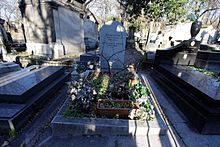Ludwig Kainer
Ludwig Kainer (born June 28, 1885 in Munich , † April 25, 1967 in Paris ) was a German graphic artist , draftsman , painter , illustrator , film architect and costume designer .
Life

Kainer had initially studied medicine, but soon turned to art. During a stay in Paris in 1909, Kainer began to discover his great love of painting, especially the Impressionists ( Paul Cézanne , Henri Matisse and Auguste Renoir ) and taught himself the basics of this art. The Munich resident also made contact with the Ballets Russes around Sergei Djagilew and Vaslav Nijinsky and made his first contributions to Simplicissimus (205 total until 1930), while he was only occasionally represented in his youth from 1909 onwards.
Back in Germany, Kainer settled in Berlin in 1910. He now worked primarily as a graphic artist, designing and drawing posters (e.g. for events with the grotesque dancer Valeska Gert , but also for book advertising). From 1912 Kainer's illustrations were also featured in magazines such as Der Sturm , Styl , Kleiderkasten and Die Dame . In 1914 he designed the cover of Kurt Pinthus ' Das Kinobuch , and in the same year Kainer exhibited at the Bugra in Leipzig .
Immediately after the outbreak of the First World War , Kainer switched to the film industry, where he designed the buildings primarily for Oskar Messter's productions , including numerous films with Henny Porten but also for various productions by Robert Wiene . In the later years several orders as costume designer were added. In addition, Ludwig Kainer took over the artistic direction of the ballet Erik Charells .
After almost a decade, Ludwig Kainer temporarily stopped filming in 1924 and went to India until the following year . Back home in Germany, Ludwig Kainer was now also active as a set designer; In the late 1920s and early 1930s he is verifiable as head of equipment for the theater in the Admiralspalast ( Haller -Revuen) under the direction of Hermann Feiner , most recently he was a member of his artistic advisory board. Since then, Kainer's cinematic excursions can be counted on one hand.
In 1933 Ludwig Kainer had to emigrate. He first went to Switzerland , soon afterwards he settled in Paris, where he was last proven in 1939 as a film architect (at Entente Cordiale ). After 1945 Kainer worked in Germany and Switzerland as well as in his adopted home France. In 1951 he was represented at a collective exhibition at the Wolfsberg art salon in Zurich , and a little later he gradually withdrew into private life.
Ludwig Kainer also worked as a teacher, so he was in charge of fashion drawing at Berlin's famous Reimann school . Several of his paintings have been put up for sale in art auctions. He met his temporary wife, the Austrian painter and draftsman Lene Schneider (1885–1971), during his first stay in Paris (1909/10).
Kainer died in Paris at the age of 82 and found his final resting place in the Père Lachaise cemetery (Division 7).
Filmography
as a film architect, unless otherwise stated
Web links
- Works by and about Ludwig Kainer in the German Digital Library
- Biography on bildindex.de
- Ludwig Kainer in the Internet Movie Database (English)
- Ludwig Kainer at filmportal.de
Individual evidence
- ↑ Ludwig Kainer auction results - Ludwig Kainer on artnet
- ^ Art prices, art appraisal - Search free
- ^ Ludwig Kainer - Works - Prices and estimates of works by Kainer
- ^ Ludwig Kainer - Artist, Fine Art, Auction Records, Prices, Biography for Ludwig Kainer
| personal data | |
|---|---|
| SURNAME | Kainer, Ludwig |
| BRIEF DESCRIPTION | German graphic artist, draftsman, painter, illustrator, film architect and costume designer |
| DATE OF BIRTH | June 28, 1885 |
| PLACE OF BIRTH | Munich |
| DATE OF DEATH | April 25, 1967 |
| Place of death | Paris |